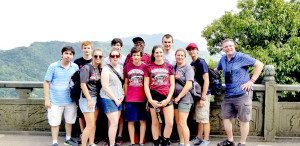By David Fleet
Editor
A box of random parts, American students, a robot along with some stellar technology was just the right mix recently to bring divergent worlds together. 
Last month robotics team Metal Muscle 1506 of Kettering University and nine other international teams were invited to Hangzhou, China to compete in the Qianjiang International Robotics Invitational. The event at the Hangzhou International Expo Center was in conjunction with the Robotics Championship—China where 43 of the top teams were to compete. Hangzhou, the capital of China’s Zhejiang province has a population of more than 9 million and is located near the East China Sea north of the island of Taiwan.
John Wolfert, is the executive coordinator of the FIRST Center at Kettering and Brandon township resident was one of five coaches that traveled with the team from July 22 to Aug. 3. The International teams worked with what they call “pre-rookie” teams to build a robot to compete in the event. Tori Bradburn, a 2018 Brandon graduate and current Kettering University student along with Nick Bradburn a Brandon High School freshman are members of Metal Muscle.
“The experience was unbelievable,” said Wolfert. “My goal was to have the students (and mentors) see and understand that all people are basically the same, we may come from different cultures, backgrounds, governments, but we all love our families, have dreams, and are passionate about our work.”
The students involved are also responsible for fundraising. In 2017 Metal Muscle raised $60,000 to build the robot alone. Not enough to get to China. The trip cost the team about $42,000, the funds where collected through Kettering University crowdfunding, alumni, the Michigan Economic Development Corporation along with FIRST Robotics of China.
“Metal Muscle helped Team 9102 of Hangzhou Infinity Intelligence – H.I.I.,” he said, a very small high school. “We helped them complete a working robot with an elevator system and autonomous mode in three days. H.I.I. did 90 percent of the work, we just guided them. We wanted HII to be able to debug the robot if there were problems.”
Like FIRST Teams worldwide building process began on Jan. 6 when FIRST released the details of the 2018 game to all teams.
“They lacked necessary game pieces for the robot to compete,” he said. “We were limited on motors and everyone was looking for ways to make things work. But when you get smart kids, they figure it out. They spoke very little English but technology is technology.” Much of the communication was through the Chinese’s multi purpose app “WeChat.” Also code is code and the programming process went very well.”
Since it was the China’s Championship only Chinese teams could compete. However, all the international teams including Metal Muscle could competed in the Qianjiang International Robotics Invitational. In that event Metal Muscle finished first.
“Working your strategy out when language is a barrier can be interesting,” he said. “Communication between drive coaches/teams during the matches can be entertaining also. In the end we were in the second alliance with 694 (Stuypulse – N.Y., NY) and 5522 (Stargazer – China). Our autonomous mode was hitting on all cylinders and we had our ‘A-Team’ driving in the eliminations. The second alliance never lost a match, winning the event.”
The efforts of Metal Muscle help push their Team 9102 – HII to the winning alliance and the China Championship.
“We won twice that day,” said Wolfert.
The international teams included: Team 66 – Grizzly Robotics – Ypsilanti, Mich., Team 359 – Hawaiian Kids – Waialua, Hi., Team 694 – StuyPulse – N.Y., N.Y., Team 1506 – Metal Muscle – Flint, Mich., Team 1595 – Dragons – Spokane, Wash., Team 1678 – Citrus Circuit – Davis, Calif., Team 2826 – Wave Robotics – Oshkosh, Wis., Team 2834 – Bionic Black Hawks – Bloomfield Hills, Mich. and Team 4613 – Barker Redbacks – Sydney Australia.
“As Americans we were treated very well,” he said. “FIRST Robotics in China provided three buses for the international teams and a two day tour of the country. Their roads are much better then ours. We also visited a mall and the Chinese wanted seflies with Americans. It was a big deal to them.
The students gained confidence in their abilities, added Wolfert.
“The culture and language barriers are more like bridges not walls,” he said. “They found greater confidence and problem solving skills. Everyone fails but it’s how you get past it is the key. That was the case in China. At the end everyone understood we are all much more alike than we are different. The goal is to do this every year with a set of six students, three mentors and a representative from Kettering University.”
